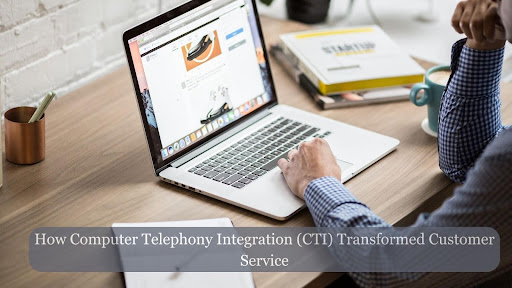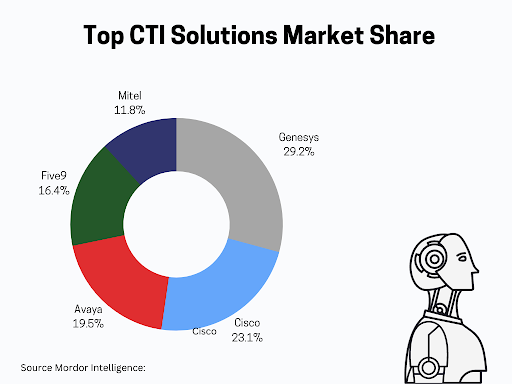Computer Telephony Integration (CTI) has revolutionised customer service by seamlessly blending telecommunications and computer systems. This technology enables many transformative benefits, including automatic call routing, real-time access to customer data, and intelligent call routing based on customer history. CTI has streamlined operations, reduced wait times, and improved overall efficiency, leading to faster issue resolution and increased customer satisfaction. Moreover, it has empowered agents with the tools to provide personalised, practical support. In today’s digitally-driven world, CTI stands as a cornerstone in the evolution of customer service, elevating it to new levels of excellence.
Computer Telephony Integration (CTI) has revolutionised how businesses interact with customers and call center solutions. Its evolution from basic screen-pop software to today’s omnichannel platforms has enhanced customer experiences and streamlined contact center operations. This article explores CTI’s transformative impact on customer service.
The Evolution of CTI in Enhancing Customer Interactions
In its early days starting in the 1980s, CTI technology was limited to very simple capabilities like automatic number identification and basic screen pops. As a call came in, the customer’s phone number would be used to find their account information and populate the agent’s screen. This eliminated tedious manual lookups and enabled agents to greet customers in a more personalized way.
Over the next decade, CTI capabilities expanded to include click-to-dial features, advanced screen pops triggered by incoming calls, integration of multiple data sources, and call controls right from the agent’s desktop. CTI liberated agents from physical telephone handsets, allowing all call handling to be done via the computer screen.
Major CTI impact started to be seen in North America and West European markets in the 1990s as large call centers expanded rapidly. CTI solutions helped call center agents improve their productivity by 15-20% as per industry estimates. Customer satisfaction also rose as CTI enabled agents to serve customers faster with more relevant information at hand.
Proprietary CTI protocols from different PBX vendors initially created walled gardens, restricting third-party application development. But gradually, open standards like CSTA, JTAPI, TSAPI, and TAPI brought interoperability to CTI systems. This spurred faster innovation and allowed CTI to be deployed across diverse voice infrastructure.
As call centers evolved into modern contact centers, CTI expanded from just telephony to include other customer interaction channels like email, live chat, and social media. Context-aware CTI now plays a pivotal role in omnichannel customer engagement platforms.
Key Players and Their Contributions to CTI Development
The early development of CTI technology was primarily driven by telecom equipment giants like Lucent Technologies, IBM, ZTEL Corporation, and AT&T.
Lucent Technologies (formerly AT&T) contributed enormously to shaping CTI deployments at scale through the widespread adoption of its telecom systems by call centers in the 80s and 90s. Its CTI offerings evolved from call control integrations on PBXs to robust data integrations between voice and CRM systems.
IBM delivered some of the earliest forms of CTI to seamlessly bridge voice and data systems for businesses. By acquiring specialized CTI vendors like ROLM Communications and Tiger Software, IBM bolstered its portfolio of telephony integration and call center solutions.
ZTEL Corporation was one of the pioneering companies that introduced sophisticated CTI capabilities like screen pop, click-to-dial, and computer-based call control to business phone systems in the 90s. Its innovations brought information-enabled communications to office environments.
Digital Equipment Corporation (DEC) created the TSAPI standard in 1995 to enable third-party CTI applications on telecom systems beyond proprietary offerings. This accelerated CTI innovation. Tiger Software also played a key role by delivering easy integrations between customer data and carrier voice networks through compliance with the popular TAPI standard.
The CTI industry has since seen extensive mergers, acquisitions, and rebranding of major vendors. While some early CTI pioneers were acquired by telecom giants, new specialized CTI vendors also emerged, especially in the cloud era. However, the pioneering work of early CTI companies laid the foundation for recent innovations.
The Paradigm Shift in CTI Hardware and Technologies
In its early days, CTI technology was delivered primarily through on-premise solutions running on private branch exchanges (PBX) and proprietary servers installed at company sites. Much of the early CTI capabilities also relied heavily on close integration with specific PBX systems and desk phones.
In the late 1990s, the advent of Voice over IP (VoIP) opened new possibilities for CTI by allowing it to leverage digital network connectivity. IP telephony standards like SIP created more interfaces for CTI to integrate with and control third-party endpoint devices.
In the cloud era, CTI has made a decisive shift from hardware-based models needing onsite installation to flexible software-as-a-service (SaaS) platforms. The reliance on traditional telephone system vendors has also declined, replaced by independent SIP phone producers.
uaCSTA, a user-agent flavored version of CSTA, has emerged as a popular standard for CTI control of SIP-based endpoints. Its support by IP phone vendors has led to greater sophistication of CTI capabilities on desktop and mobile devices.
Diverse Types of CTI and Their Impact on Customer Service
Modern CTI solutions come in many flavors, designed to meet different customer service needs:
Omnichannel CTI offers seamless integration of voice, email, live chat, social media, and other channels on a single CTI platform. This enhances customer experiences through unified, context-aware interactions across channels.
On-premise CTI runs on a company’s own servers, offering deep customization and full control of data security. But it requires significant upfront investments and IT skills for deployment and maintenance.
Serverless CTI as a cloud-based solution needs no infrastructure investment from companies. This enables easy scalability to manage sudden call volumes. But serverless CTI can have limited integration capability with on-premise systems.
Browser-based CTI enables core CTI capabilities like screen pops, click-to-dial and call controls directly through web browsers. This offers quick deployment but relies on stable internet connectivity.
Overall, modern CTI solutions provide powerful features like screen-pops, intelligent call routing, real-time data integration, CRM embeddings, and call analytics. This empowers companies to reduce costs, save time, improve customer satisfaction, monitor agent performance, facilitate remote work, and enhance training.
Frequently Asked Questions
How has CTI adapted to cloud computing and serverless architectures?
Cloud-based CTI has gained significant traction thanks to easy deployment, flexibility, and cost savings. Integration with messaging platforms enables omnichannel customer experiences. AI brings smarter call routing and analysis.
What challenges do businesses face when integrating CTI with existing systems?
Legacy telephony systems might lack open architectures for easy CTI integration. Disparate vendor systems may have compatibility issues. On-premise solutions can be complex to deploy. Security, compliance, and data ownership should be evaluated.
How do modern CTI solutions ensure data security and privacy?
Reputable CTI vendors comply with regulations like HIPAA and PCI DSS. Encryption and role-based access safeguard customer data. Cloud-based options leverage the security measures of hosting platforms. On-premise deployments give full control over data and systems.
Conclusion
From its early days of screen-pops to the advanced AI-driven omnichannel platforms we have today, Computer Telephony Integration (CTI) has undergone a remarkable transformation, fundamentally redefining the landscape of customer service. Throughout its evolution, CTI has proven to be a game-changer, enabling businesses to streamline communication, enhance efficiency, and ultimately elevate the customer experience. What’s even more exciting is that CTI’s future appears brighter than ever.
With the flexibility to tailor CTI solutions to the unique needs and sizes of organizations, it has become an indispensable tool for businesses across various industries. Small startups and global enterprises alike benefit from CTI’s ability to integrate with existing systems, automate routine tasks, and provide a unified view of customer interactions. This adaptability and scalability ensure that CTI will remain a valuable asset to businesses of all sizes, contributing to their growth and success.
As technology continues to advance, CTI is poised to innovate further, pushing the boundaries of what’s possible in customer service. AI and machine learning will play an increasingly significant role, enabling predictive analytics, real-time insights, and even more personalized customer interactions. These developments will not only enhance operational efficiency but also empower businesses to deliver exceptional customer experiences, setting them apart in competitive markets.
Throughout this evolution and into the future, one thing remains constant: CTI’s unwavering commitment to putting customer experience at the heart of business success. It’s this customer-centric approach that will continue to drive CTI’s growth and ensure that it remains a driving force in shaping the future of customer service, where every interaction is a chance to leave a lasting, positive impression on customers.



